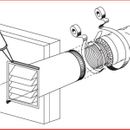HRV port installation
Can anyone point me to a detail for passing HRV ports through a thickly insulated envelope?
I haven’t decided yet whether I will pass the ports through the rim board assembly or the wall above – I’m leaning towards the wall above so as to lift the ports well above the winter snow line.
The manufacturer’s installation detail calls for simply passing through a 6″ galvanized round duct… but I’m not sure I like this approach.
Another approach I have been considering is to use, say, 6.5″ or 7″ PVC as a conduit for the 6″ galvanized duct, then filling the gap between with one-part foam…
GBA Detail Library
A collection of one thousand construction details organized by climate and house part










Replies
PVC seems like overkill...
Lucas,
I've never heard of 6.5 inch or 7 inch PVC pipe. But there is nothing wrong with your idea.
However, remember that most walls are insulated anyway. Presumably the galvanized pipe that penetrates the wall will be surrounded by insulation, no matter how you detail the penetration.
One important point: the pipe should slope outwards, so that any condensation drips outside of your house.
Seems like sleeving the pipe is going to create an added flashing hassle later on. I would run the duct right through the wall, through a 2x block, then flash the block as you install WRB and siding. A sleeve is only useful if you need to install the duct later for some reason, or need to be able to remove/replace the duct down the road. We install sleeves for plumbing pipes through concrete foundations, but that's usually because we're ahead of the plumber, so we leave him access that doesn't require core-drilling. In a wood wall, no reason for that.
Thank you, Martin and David.
My concern was that, with a wall assembly that is relatively vapour open to the exterior, under certain conditions there might be a risk that the [outside of the] galvanized duct might "sweat" in the wall...
Have either of you ever heard of anything like this before?
Anyone from a mixed, humid climate out there ever heard of anything like this?
The summers in my area have recently been seeing much longer spells of hot, humid weather...
So the concern is that the exhaust port might have cool enough air in it to reach dewpoint on the outside of the metal, inside the wall somewhere, when it's hot/humid outdoors?
I suppose in that case, your strategy of installing a sleeve around the pipe, filled solid with one-part foam, would prevent that. If you do this, I would terminate the sleeve on the inside face of the sheathing and only penetrate with the duct itself, unless you're prepared to do some fancy flashing work to leak-proof the whole thing... which of course you could do. What does your wall cap look like?
I haven't heard of galvanized steel duct being an issue in practice in any climate. If you're really concerned about it though, you could also consider using Zehnder's "Comfopipe", made from Expanded Polypropylene.
http://www.zehnderamerica.com/products/product_list.aspx?CategoryID=3
David,
Yes, that was the concern and I haven't purchased the caps yet.
I have been refering to this JLC article.
In it, the author describes using PVC at the ports, but it seems like a slightly different application...
Anyway, I really don't want to use PVC at all if I don't have to...
I'm open to other suggestions on how some kind of impermeable insulation could be applied to the exterior of the galvanized duct.
Or whether this is even an issue at all - I'm not sure it isn't but I'm not sure it is either.
John,
Thanks for the link.
Never heard of the "comfopipe" before.